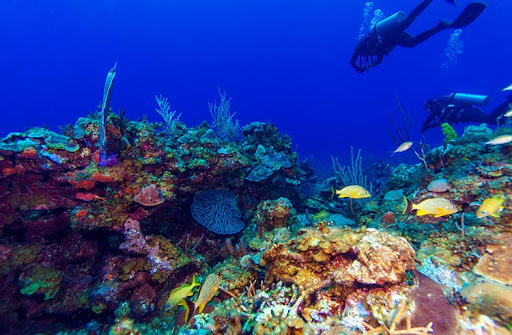The Republic of Cuba, made up of the island of Cuba (the largest island in the West Indies covering 1250 km for about 200 km on its largest part), the Isle of Youth and some other small islands, is located west of the Caribbean at the confluence of the Caribbean Sea, the Gulf of Mexico and the Atlantic Ocean. To travel to Cuba is to put a foot in history. With a rich cultural heritage, intact colonial architecture, churches and museums, American and russians cars from the 1950s, warm music invading the streets or ever-present paints of Che Guevara and Fidel Castro, travelers will return from their journey charmed by the atmosphere ... as much under water as on land! This archipelago with turquoise and transparent waters has hundreds of islets called cayos. While diving in cuba, you will also make some beautiful and varied underwater encounters. For your diving trip in Cuba, you will have to choose between several destinations:
Best areas for a diving holiday?
Diving holidays on the Isle of Youth
80 km south-west of Havana, in the Canarreos archipelago, the Island of Youth includes 672 islands, islets and Cayos, surrounded by turquoise lagoons. This magnificent island has been discovered in 1494 by Christopher Columbus during his second exploration. The island then became a base camp for all pirates of the Caribbean. Moreover, some divers have discovered chests filled with gold coins. This treasure island is home to fifty dive sites with fantastic underwater architecture. In this setting, we admire an exceptional biodiversity composed of giant black coral gardens, tubular sponges, coral brain, caves, tombs, craters and shipwrecks where many varieties of fish mix with little fierce .
Diving trip to Maria La Gorda
In the western part of the island, in the area of Pinar del Rio, the isolated site of Maria la Gorda is internationally famous for its dives along big drop-offs covered with black corals. Accessible only if you are motorized, this haven of peace is classified biosphere reserve by UNESCO. This status has protected the many underwater species and corals of the area. There are no less than 38 species of hard corals, 27 species of gorgonians and 39 species of sponges. During the months of May and June, the sandy beaches of Maria Gorda serve as nesting places for sea turtles. A diving trip to Maria La Gorda is therefore an obligatory stop of your diving trip.
Bay of Pigs and Playa Larga
If you are looking for a easily accessible place from Havana with many nice dives, the easiest way is to go to Playa Larga, a charming little village by the sea or to Playa Giron. From there taxis can take you to the Cueva de los Peces which is a falling coral 70 meters high about 50 m from the shore. Small wrecks of landing barges rest on the edge of the wall. On the other side of the road, opposite the restaurant, there are several cenotes inundated with fresh water and salt water. On Route 11, there is another rest area: Punta Perdiz with a dive center and many dive sites. Once again, a superb drop off will allow you to observe the fauna and flora of the Caribbean.
Jardines de la Reina
Located about 100 kilometers or five sailing hours from Cuba, the Queen's Gardens is an uninhabited archipelago that became a national park in 2002. Composed of nearly 600 cayos and covering an area of 2170 km2, it is one of the largest protected areas of Cuba. This archipelago is home to a preserved ecosystem that makes it one of the best diving spots in the world. Coral reefs are recognized as some of the most beautiful of the Caribbean. The mixture of ocean currents with the Caribbean Sea load this area with nutrients that reef fish enjoy very much. A busy life always attracts predators and big fish. The result is a magical underwater landscape and abundant wildlife.
Playa Santa Lucia
1.5 km offshore is one of the longest coral reefs in the world. This is where local dive clubs organize Shark Feeding with bull sharks.
Cienfuegos
In Cienfuegos, the dive site Banco de Jagua, although hard to reach and deep enough, is worth a visit. On this sunken pinnacle, you can admire many marine species, including barracudas, parrot fish, stingrays, sea turtles, reef sharks and sometimes even hammerhead sharks, over a coral garden. or whale sharks.
Finally there are other dive sites all over Cuba, including Varadero, you will have the opportunity to explore small wrecks and less abrupt drop offs than in southern Cuba.
Cuba Liveaboard
To enjoy a very exclusive Cuba diving trip, you will have the very interesting option to book a liveaboard in Cuba. There is a good selection of cruise diving boats in Cuba including those of the Aggressor Fleet, the only international fleet represented in this country. This group has 2 diving cruises in cuba: Jardines Aggressor I and Jardines Aggressor II. Another local dive operator, also has a good option: the Avalon Cuban Diving Centers. It has exclusive rights over certain regions and offer 4 different diving boats in cuba but also has a floating hotel called Tortuga. They arrange for the different boats to have different routes so that you are always the only ones on a dive site. These two fleets cover all the best diving spots in Cuba. Take a look at this website to book your dive cruise in Cuba. Their prices are often the lowest, and it is possible to book without pre-payment.
The best season to dive in Cuba
Cuba has a tropical climate with two different seasons. The dry season, that lasts from November to April and the wet season from May to October. We would tend to advise you the dry season given the fact that cyclones often pass by Cuba and the Caribbean during the summer.
Diving conditions
Visibility is generally good while scuba diving in Cuba and often exceeds 40 meters. To maximize your chances, aim for the dry season. The marine currents are not very strong in Cuba. The northern coast of Cuba, subject to ocean currents present more uncertainty and has large tidal coefficients. Ask your dive club for advice. Levels required: It might be a good choice to learn scuba diving in cuba as the underwater conditions are excellent. However, no American federation is allowed on the island because of the embargo. It will be necessary to have confidence in the local instructors whose seriousness and the level of English is not always at the height. If you have any doubts about the professionalism of the dive center, go your way. Keepp in mind that you won't be able to receive a PADI or SSI certification in Cuba. The temperature of the water oscillates all year round between 25 and 30 ° C.
Security in scuba diving
As I mentioned above, Cuba is the only country in the world where diving centers are not affiliated with the major American diving federations PADI and SSI. This is due to historical and political reasons with the United States. If you are going on a Cuba diving trip, I recommend that you check that your travel insurance also covers scuba diving. If you have a doubt or are not covered, you can subscribe to this travel insurance which, in addition to offering a worldwide coverage, integrates many risky sports such as scuba diving.
What to see in scuba diving in Cuba?
The underwater world in Cuba is composed of many coral reefs among the most beautiful of the Caribbean and the world. There are hundreds of different corals including black corals sublime or elephant ear corals quite rare. Expect to meet sea turtles, barracudas, large groupers, tarpon, moray eels, stingrays, jacks, yellow headed wrasse, blue surgeons, chests, angels, fish parrots, scorpion fish and even some sharks. At Queen's Gardens, you can admire up to 5 species of sharks including silky sharks and gray sharks of the Caribbean. In the mangroves of this archipelago are also hiding American crocodiles up to six meters long. From July to November, during the wet season, the waters are full of plankton, so it is possible to dive with the largest fish in the world: the whale shark. For macro photography enthusiasts, there are many specimens of cleaner shrimps, porcelain crabs, dozens of nudibranch species and even seahorses.
Source:



Load more comments